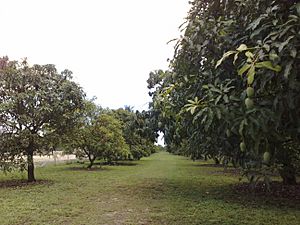Ice Cream (mango) facts for kids
Quick facts for kids Mangifera 'Ice Cream' |
|
|---|---|

Fruit & Spice Park mango grove
|
|
| Genus | Mangifera |
| Species | Mangifera indica |
| Cultivar | 'Ice Cream' |
| Origin | Trinidad and Tobago |
The Ice Cream mango is a special type of mango that doesn't grow very tall. It first came from the islands of Trinidad and Tobago. Later, it was brought to Florida in the United States. This mango is known for its small size and sweet, spicy taste.
Contents
How the Ice Cream Mango Was Discovered
The Ice Cream mango was first found in Trinidad and Tobago. A person named Maurice Kong helped bring it to the United States. It arrived in Florida through the Rare Fruit Council International. We don't know who its "parents" (the original mango trees it came from) were.
Why It's Called a "Condo Mango"
This mango became famous because it stays small. These trees can be kept under 6.5 feet (about 2 meters) tall. Dr. Richard Campbell from the Fairchild Tropical Botanic Garden even called it a "condo mango." This means it's perfect for small spaces, like a balcony or a small yard. Many people in Florida grow Ice Cream mango trees in pots.
Where Ice Cream Mangoes Grow Today
Today, you can find Ice Cream mango trees planted in special gardens. They are at the USDA tropical fruit collection in Miami, Florida. You can also see them at the Miami–Dade Fruit and Spice Park in Homestead, Florida.
What the Ice Cream Mango Looks Like
Ice Cream mangoes are quite small. Each fruit usually weighs about eight ounces (half a pound). They are typically yellow-green, even when they are ripe. They don't get a red color on their skin. The fruit has a flat, oval shape and a slightly bumpy surface.
Taste and Texture
The inside of the Ice Cream mango is very special. It has no stringy fibers, which makes it smooth to eat. The taste is rich, sweet, and a little bit spicy. Some people say it tastes like mango sorbet! Each fruit has one large seed inside. In Florida, these mangoes are ready to eat from June to July.
Growing the Tree
The Ice Cream mango tree doesn't grow very fast or tall. It can be kept under 8 feet (about 2.4 meters) in height. This makes it easy to manage. The plant is also good at resisting common plant diseases and pests. However, in Florida, these trees don't always produce a lot of fruit on their own. If different types of mango trees are planted nearby, they can help each other produce more fruit.

